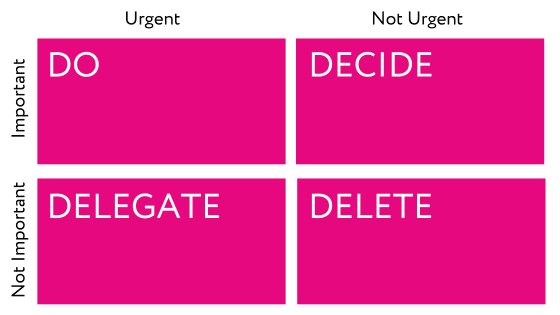Have you ever ended your workday feeling like you’ve been running at full speed, only to realise you haven’t made any significant progress on your long-term goals? Welcome to the “urgency trap,” a dilemma that snags even the most seasoned managers, diverting attention away from impactful, strategic decisions to the immediate but often inconsequential problems of the day.
But what if I told you there’s a way that you could break free from the never-ending cycle of urgent tasks?
Enter the Eisenhower Matrix—a timeless framework that can revolutionise your task management and sharpen your focus as a leader.
Understanding the Eisenhower Matrix
The Eisenhower Matrix, named after U.S. President Dwight D. Eisenhower, provides a simple yet transformative method for prioritising tasks. The matrix is a 2×2 grid consisting of four quadrants:
Urgent and Important (Quadrant I): Crises, last-minute deadlines, or emergency issues that demand immediate attention.
Important but Not Urgent (Quadrant II): Long-term planning, team development, and strategic initiatives.
Urgent but Not Important (Quadrant III): Emails, meetings, and minor tasks that seem urgent but don’t contribute to long-term goals.
Neither Urgent nor Important (Quadrant IV): Tasks that effectively waste your time, like social media browsing or activities that offer no real value.
The Allure of the Urgent
Why do managers often fall prey to the urgency trap? The answer lies in the immediate satisfaction derived from tackling urgent tasks. There’s a natural adrenaline rush in solving problems on the fly, but it often comes at the expense of those activities crucial for your career and organisational growth.
The Unexplored Potential of Quadrant II
Spending more time in Quadrant II is the key to defeating the urgency trap. Tasks in this quadrant are your strategic weapons for long-term success. Whether it’s nurturing team dynamics, strategising for the next quarter, or investing in your personal development, these activities, although not urgent, are what genuinely propel you forward as a leader.
The Eisenhower Matrix in Action: A Step-by-Step Guide
1. Inventory Your Tasks: List every duty, commitment, and responsibility you have on your plate.
2. Sort Into Quadrants: Classify each item in one of the Eisenhower Matrix’s four quadrants.
3. Prioritise: Focus first on tackling Quadrant I (urgent and important) tasks and then set aside dedicated time for Quadrant II (important but not urgent) activities.
4. Delegate or Defer: Relegate Quadrant III (urgent but not important) tasks to team members when possible and either postpone or eliminate Quadrant IV (neither urgent nor important) tasks.
5. Regular Review: To keep your priorities aligned, make it a habit to review and update your matrix at least once a week.

Case Study: From Chaos to Control
Let’s take Jane, a middle manager in a fast-growing tech firm, as an example. Before utilising the Eisenhower Matrix, Jane was often overwhelmed with emails, meetings, and ad-hoc requests. Her team’s performance started to dip, and her strategic projects were perpetually in limbo.
After implementing the Eisenhower Matrix, she saw how her time was disproportionately spent in Quadrants III (urgent but not important tasks) and IV (neither urgent nor important tasks). This prompted Jane to delegate less critical tasks and set aside focused hours for Quadrant II activities (important but not urgent tasks). Within a month, her team’s productivity soared, and she found the time to develop a comprehensive strategy for the upcoming quarter.
Common Pitfalls and How to Avoid Them
While the Eisenhower Matrix is a powerful tool, it has challenges. Here are some common pitfalls and how you can avoid them:
Overestimating Urgency: Labelling tasks as urgent is easy, particularly when accompanied by external pressures. To counteract this, ask yourself whether the task will have long-term consequences or a short-term distraction.
Underestimating Importance: Tasks like team-building and long-term planning might not scream “urgent,” but their cumulative impact is significant. Don’t let these fall by the wayside.
Failing to Revisit: The Eisenhower Matrix is not a “set it and forget it” tool. Circumstances change, and so should your matrix. Make it a habit to review and adjust your matrix regularly.
Ignoring Quadrant IV: While these tasks should be minimised, complete elimination is neither practical nor healthy. Balance is key, so ensure you allocate limited but specific time for these activities as well.
Tips for Effective Implementation
The Eisenhower Matrix can be a game-changer, but only if executed correctly. Here are some pro tips to make the most of this strategic tool:
Time Blocking: Schedule specific blocks of time for Quadrant II activities (important but not urgent tasks). This ensures that they get the attention they deserve.
Use Technology: There are several apps and digital platforms designed to facilitate the Eisenhower Matrix method. Utilising them can streamline the process.
Team Involvement: Make it a team exercise to create a collective Eisenhower Matrix. This fosters a sense of shared responsibility and aligns the team’s efforts with organisational goals.
Seek Feedback: Don’t hesitate to consult with peers or mentors to gain an external perspective on your prioritisation. Sometimes, an outsider’s view can offer invaluable insights.
Defeating the urgency trap requires the right tools, discipline, and foresight to use them effectively. The Eisenhower Matrix is more than just a time management tool—it’s a leadership tool. It provides a framework that enables you to exercise judgement over urgency and importance, transforming how you manage tasks, lead teams and shape organisational outcomes.
By avoiding common pitfalls and adopting effective implementation strategies, you won’t just be managing time but leading with vision and clarity.
So go ahead, try the Eisenhower Matrix, and take the first step in defeating the urgency trap that may be holding you back.
Author: Gemma Rolstone | Published 5th September 2023.




